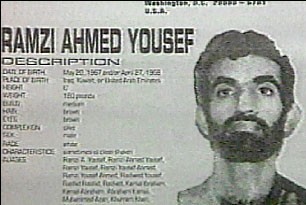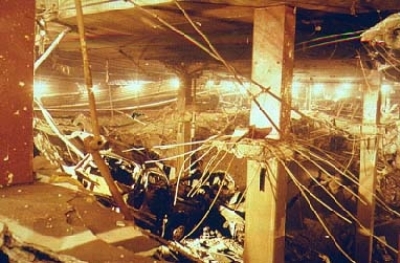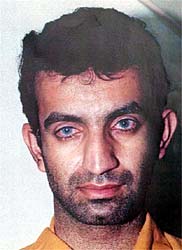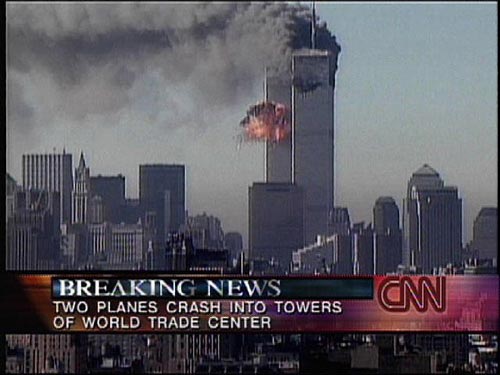|
Ramzi Yousef Ramzi Yousef's most recent distinction is his status as the resident of the most expensive studio apartment in the history of the world. His 7 by 12 foot luxury suite comes complete with convenient toilet in the living room, 13-inch black and white TV and the handy chute through prison guards slide his delicious meals.
Ramzi Yousef's most recent distinction is his status as the resident of the most expensive studio apartment in the history of the world. His 7 by 12 foot luxury suite comes complete with convenient toilet in the living room, 13-inch black and white TV and the handy chute through prison guards slide his delicious meals.It cost hundreds of millions of dollars to build the Colorado Supermax prison, and somewhere significantly upwards of $20 million to keep it secure each year, and that doesn't even include free HBO. However, it's hard to imagine you could ever spend "too much" to keep Ramzi Yousef locked up. The only thing more impressive than the terrorist attacks he accomplished are the ones he didn't have time to finish before he was caught. And there's no doubt in anyone's mind that if he ever got out of prison, he would pick up right where he left off. He's just that kind of guy. Yousef's nationality is a matter of some dispute, but it's believed he was a native of the Baluchistan area of Pakistan, a wild lawless border region with deep and broad ties to terrorism and al Qaeda. Yousef's uncle and partner-in-crime, Khalid Shaikh Mohammed, is also believed to hail from Baluchistan. Yousef (whose birth name is probably Abdul Basit Karim) appears to have been raised in Kuwait, where the man thought to be his father was a worker. Immigrant workers in Kuwait at the time were roughly equivalent in social status to black slaves in the deep South prior to the civil war; Yousef's biographers speculate that this upbringing might explain a lot. As a young man, Yousef attended college in the U.K., where he studied electrical engineering, a skill he would put to productive use. During the late 1980s, he began spending his spring breaks in Pakistan, where the girls don't go wild, but everyone else does. He visited al Qaeda training camps in the border region between Pakistan and Afghanistan, where he learned the ins and outs of firearms and explosives. It turned out that young Ramzi had a particular genius for the latter, and he was soon promoted from student to teacher. A diabolical designer of explosives, bombs would make his name (or rather, his alias) a household name (in households that read newspapers).
Blowin' Shit UpThe first major explosion Ramzi Yousef added to his resume was significant in a number of ways -- the World Trade Center.In late 1992, Yousef entered the country with a fake Iraqi passport and asked for asylum. His traveling companion was arrested immediately when a search of his luggage revealed bomb-making manuals. Because the INS holding cells were overcrowded, Yousef was released with instructions to come back a month later for a hearing. D'oh! Yousef traveled around New York and New Jersey, immediately contacting a cell of Islamic Jihad operatives loyal to the notorious blind Sheikh Omar Abdel Rahman, a controversial extremist Muslim preacher who had been granted entree to the country by the CIA (which had hoped to befriend him). D'oh! D'oh!
Yousef was able to get the bomb-making manuals seized from his travel companion after a judge ordered the property returned to its owner (who remained incarcerated). D'oh! D'oh! D'oh! D'oh! He gathered together his list of motley conspirators and began buying and mixing chemicals for his big bomb. At one point, Yousef was injured in a car accident. The cop on the scene testified that she "felt a little sorry for him because he was so far from home." After recovering with a brief hospital stay, Yousef was able to recover the bomb-ingredients that remained in the trunk of his car while it sat in a police impound. D'oh! D'oh! D'oh! Argh! D'oh! Do'h! A couple days before the bombing, one of Yousef's accomplices rented a Ryder van. The gang reported the truck stolen, in a ploy to slow investigators from picking up the trail after the bombing. On the morning of February 26, 1993, the conspirators drove the truck into the underground parking lot of the World Trade Center complex, lit the fuse and drove away. A few minutes later, mayhem ensued. A massive explosion ripped through the garage and one of the two towers. Six people were killed, and hundreds were injured, but Yousef failed in one key objective. He had sought to cause the collapse of Tower One in such a way that it would fall onto Tower Two, killing thousands and demolishing the complex. As it turned out, Yousef's triumph was delayed, but it would not be denied.
Thinking BiggerYousef was out of the United States before the smoke had cleared from the World Trade Center's halls. He escaped to Pakistan just hours after the bombing, where he visited with family and stayed at guest houses funded by Osama bin Laden. In Pakistan, he reacquainted himself with family members and current terrorists, including his uncle, Khalid Shaikh Mohammed.During his stay in Pakistan, Yousef organized several attempted terrorist acts, some of which succeeded (like a violent attack in Iran) and others of which did not (like the attempted assassination of then-president of Pakistan, Benazir Bhutto). In a meeting with Khalid and Abdul Hakim Murad, an old friend of Yousef's, the three discussed airplanes and pilot training. After a few months, all three were dispatched to Manila, the Philippines, under orders from Osama bin Laden to begin plotting direct strikes on the United States. As with many elements of Yousef's life, it's a bit of a mystery exactly when he first joined forces with al Qaeda. There is some evidence that the first WTC bombing may have been assisted or facilitated by bin Laden, but there's a lot more evidence that Yousef's Manila cell was an al Qaeda shop, financed by bin Laden's brother-in-law, Mohammed Jamal Khalifa. There's a school of thought that Yousef might have been working for Iraq instead of (or in combination with) al Qaeda, particularly since the first WTC bombing took place on the anniversary of the liberation of Kuwait by allied forces in the first Gulf War. However, most theories closely tying Yousef to the government Iraq tend to involve an amount of misdirection and arcane identity switching that's extreme even by the labyrinthine standards of international terrorism. The connection has never been proven. In Manila, Yousef and Khalid Shaikh let their devious imaginations run wild. They planned several schemes of various magnitudes. On orders from bin Laden, they considered plots to assassinate Pope John Paul II and President Bill Clinton. The latter was abandoned as too difficult; the former was only averted by chance. Various conspiracy theories also tied Yousef to preparations for the Oklahoma City bombing during this period.
Unlike Khalid and bin Laden, there is little evidence to suggest that Yousef was especially Muslim or that his terrorist activities were driven by religious zeal. Yousef mouthed the usual extremist mantras when eventually arrested, but there was never any indication that he comported himself with any kind of religious demeanor or according to any code of behavior even vaguely resembling Islam. Although he occasionally expressed political anger over the plight of the Palestinians, Yousef had never even visited the occupied lands. In the final analysis, it's most likely that he became a terrorist for two very basic reasons: He was good at it, and he liked it. He probably never enjoyed his work so much as in Manila. With funds flowing from al Qaeda and lots of local girls to pass his evenings with, Yousef sat down with Khalid and together they devised what would have been the biggest and most devastating terrorist in history. And they came within two weeks of pulling it off.
Project BojinkaProject Bojinka (apparently a Croatian word for "explosion") was the devious brainchild of these sessions. The plan was ruthless and devious, and it employed every scrap of ingenuity that Yousef could muster, which is saying quite a bit.In Phase One of Bojinka, a minimum of five al Qaeda operatives would work in concert to destroy 11 U.S.-bound airliners over the Pacific almost simultaneously starting on Jan. 21, 1995. The terrorists would board planes bound for the U.S. with stopovers all across Asia. They would plant bombs timed to explode on the second leg of the flight, then get off during the layover and repeat the process for another plane. The plan was elegant and highly coordinated. All five operatives would have escaped to Pakistan unharmed. If the plan had succeeded, it would have killed an estimated 4,000 people and completely shut down all air travel around the world for days or even weeks. The bombs were ingenious constructions, using Casio digital watches as timers and virtually undetectable liquid nitroglycerin as the explosive. Yousef tested the device on a flight from Manila to Tokyo on Dec. 11, 1994. He built his bomb in the lavatory and left it under his seat when he disembarked in Cebu, the Philippines. It exploded on the way to Japan, killing the businessman unfortunate enough to have taken over Yousef's seat. The plane managed to land successfully thanks to a heroic effort by the pilots. Yousef resolved to increase the potency of the explosive. On Jan. 5, 1995, one of Yousef's compatriots started a small chemical fire in the apartment where the bomb supplies were being mixed. The conspirators fled, leaving documents and alaptop computer behind. Watching smoke pour out the apartment window, Yousef calmly sent Abdul Murad back to retrieve the computer after the fire department left, but the police were already on their way and Murad was arrested. Yousef left the country a day or two later, and Khalid Shaikh wasn't far behind. Murad, left to the gentle ministrations of the Philippines police, began a lengthy confession under torture. During the course of his confession, he laid out Phase Two of Bojinka. Murad told his interrogators that he had been selected for the great honor of martyrdom (an honor the secular Yousef preferred to leave for others). Murad, who had trained as a pilot in the United States, had been instructed to hijack a commercial airliner and crash it into a U.S.landmark. Possible targets included the World Trade Center, the Pentagon and CIA headquarters. Yousef and Khalid Shaikh fled to Pakistan. One month later, U.S. officials tracked him down and arrested him. The team of FBI agents and Pakistani intelligence officials who made the arrest were so busy patting themselves on the back that they completely ignored Khalid, who was sleeping in the room next door. Yousef was flown back to the United States, and into New York, where an outstanding indictment for the WTC 1993 bombing awaited him. As the plane landed, an FBI agent pointed out the World Trade Center towers to the terrorist, and commented, "They're still standing." "They wouldn't be if I had enough money and explosives," Yousef reportedly responded.
Yousef might have been locked away, but on Sept. 11, 2001, he still managed to take one last shot at his favorite target, and this time he succeeded. An al Qaeda operation led by Khalid Shaikh Mohammed finally made the Bojinka plan a reality, hijacking four jets and crashing three of them into their targets, the World Trade Center towers and the Pentagon. It must have given Yousef some satisfaction to see the fruits of his handiwork on his tiny black-and-white TV set. With a body count around 3,000, it was only a little less mayhem than would have been caused by Yousef's first draft of the plan (which U.S. authorities had reviewed in detail well before 9/11). And this time, the towers did come down. We can only hope that was the last plan Ramzi Yousef left unfinished on the drawing board...
|
 A member of Rahman's cadre had been arrested in 1991 for the murder of radical racist Rabbi Meir Kahane. Despite being caught at the scene with a literally smoking gun in his hand after shooting Kahane in front of hundreds of witnesses, Nosair had been acquitted of murder (but was convicted on gun charges). When investigators raided Nosair's apartments, they seized dozens of bomb-making manuals and documents related to planned terrorism plots in New York City, which they didn't bother to translate from Arabic. D'oh! D'oh! D'oh!
A member of Rahman's cadre had been arrested in 1991 for the murder of radical racist Rabbi Meir Kahane. Despite being caught at the scene with a literally smoking gun in his hand after shooting Kahane in front of hundreds of witnesses, Nosair had been acquitted of murder (but was convicted on gun charges). When investigators raided Nosair's apartments, they seized dozens of bomb-making manuals and documents related to planned terrorism plots in New York City, which they didn't bother to translate from Arabic. D'oh! D'oh! D'oh! Yousef and Khalid also availed themselves of all the high living they could get their hands on. They frequented local discos and nightclubs and courted numerous local women. There are reports of scuba trips to the southern regions of the Philippines, but it seems likely these trips were cover for visits with the Abu Sayyaf, a Muslim separatist group operating in the region with funding from bin Laden.
Yousef and Khalid also availed themselves of all the high living they could get their hands on. They frequented local discos and nightclubs and courted numerous local women. There are reports of scuba trips to the southern regions of the Philippines, but it seems likely these trips were cover for visits with the Abu Sayyaf, a Muslim separatist group operating in the region with funding from bin Laden.  Yousef was convicted in a New York courtroom for both the WTC bombing and the Bojinka plot, and sentenced to life in prison without parole. Judged a high escape risk, he was sent to serve his sentence at the Supermax prison in Colorado. His cellmates included the
Yousef was convicted in a New York courtroom for both the WTC bombing and the Bojinka plot, and sentenced to life in prison without parole. Judged a high escape risk, he was sent to serve his sentence at the Supermax prison in Colorado. His cellmates included the